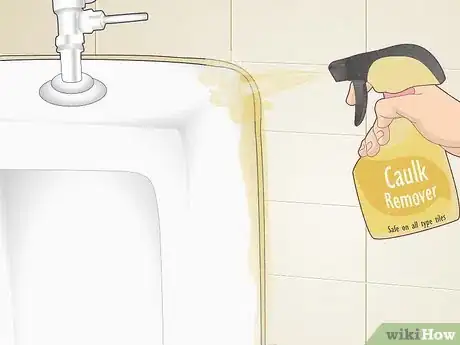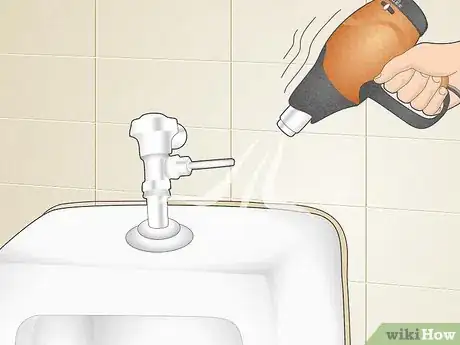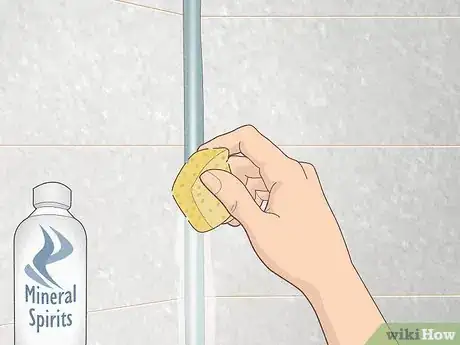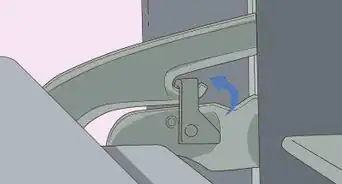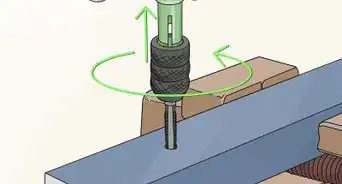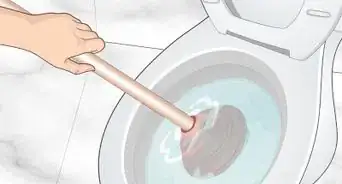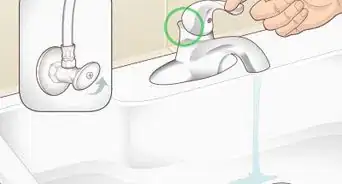This article was co-authored by Eric Shipe and by wikiHow staff writer, Eric McClure. Eric Shipe is a Kitchen and Bath Designer and the Owner of Bath + Kitchen based in Washington DC. Eric and his team specialize in cabinetry, design, and remodels. They serve homeowners, interior designers, architects, and contractors with a refined process, creative ideas, 4K photo-realistic renderings, and 360 Panoramic views. Bath + Kitchen was featured in Best of Houzz 2017-2020. Eric holds a BA in Economics and Business Administration from Ursinus College.
This article has been viewed 10,292 times.
Removing caulk is typically pretty straightforward. You cut a seam in the caulk and pull it up by hand or with some pliers. However, if the caulk is especially strong or thick, you may need to soften it up a bit to make it easier to work with. While there are caulk removal products out there for any kind of caulk, you’ll likely have better results using heat for silicone caulk and solvents with water-based latex products. Before you do any of this though, just try peeling it up by hand. You may save yourself a bit of time and energy if the caulk is already easy to remove.
Steps
Caulk Remover
-
1Go with a dedicated caulk remover for best results. Go to your local home improvement store and look for a caulk remover. If you know whether you have silicone or latex caulk, get a remover designed specifically for that.[1] If you aren’t sure what kind of caulk you have, go with an all-purpose caulk remover. These products come in liquid sprays or gels, so pick whichever you prefer to work with.[2]
- While it isn’t technically a caulk remover, a lot of DIY enthusiasts have had success using Goo Gone in a pinch.
-
2Read the label to make sure it’s safe for the surface you’re working with. Caulk removers can occasionally damage certain surfaces, so read the instructions on the label thoroughly to make sure you aren’t going to discolor or damage anything.[3]
- You can always spot-test the product if you’re worried about damaging the surface surrounding the caulk. Apply a small bit of the product to an area nobody will see and wait to see if it damages or discolors anything.
Advertisement -
3Apply the remover to the caulk and wait for it to soften up. The amount of time you need to wait depends on the product you’re using, but it ranges anywhere from 5 minutes to 6 hours.[4] Follow the manufacturer’s instructions to apply the remover and wait the prescribed amount of time before peeling the caulk up.[5]
- For sprays, you typically just spritz the entire length of caulk. Gels and pastes are usually applied directly on top of the caulk.
- When the caulk is soft, you can just peel the caulk up by hand most of the time. If necessary, you can pry it up with pliers or a putty knife.
Heat
-
1Grab a hair dryer or heat gun to soften the caulk. Caulk will become super soft if it gets warm enough, so grab a hair dryer or heat gun.[6] This is generally going to be an efficient way to go, and it should work with either silicone or latex caulk.[7]
- You may not want to go this route if the caulk is on any kind of malleable plastic, which may melt. Heat may also discolor painted surfaces. This should be totally safe with masonry, tile, or wood, though.
- It doesn’t take a lot of heat for this to work. If the caulk is in an area that’s exposed to the sun, removing the caulk near the end of a warm, sunny day should help this process along (or prevent the need for it entirely).
-
2Turn the heat on to the lowest available setting. The biggest risks here are damaging the surface underneath the caulk with excess heat, or melting the caulk to the point that it becomes goopy and more difficult to remove. As a result, start off with the lowest heat setting on your hair dryer or heat gun. It doesn’t take a ton of heat to soften up the caulk.[8]
-
3Move the dryer or heat gun back and forth along the caulk to soften it up. Hold your heat source 6–12 inches (15–30 cm) away from the caulk. Move the heat source continuously along the length of caulk you want to soften to avoid letting the heat build up in any single location. After a minute or so, try removing the caulk.[9]
- The amount of time that it will take for the caulk to soften up is going to vary depending on the type and age of the caulk. It shouldn’t take a ton of time for the caulk to soften up, though.
- Once it’s soft, you should be able to peel the caulk up by hand. You can use a putty knife or pliers if you need some extra leverage.
Solvent
-
1Grab mineral spirits if the caulk is on concrete, marble, or ceramic. Mineral spirits should help to soften the caulk, but this stuff isn’t safe on any painted or porous surfaces.[10] You can either soak a rag with the spirits and lay that on top of the caulk for a bit, or scrub the caulk directly with a spirit-soaked scouring pad or sponge to wear it down.[11]
- Mineral spirits will cause the caulk to swell a bit, which will weaken its adhesion.
- Wear gloves and keep a window open while you work with mineral spirits. It’s not super dangerous stuff, but it can irritate your skin and it smells pretty strong.
-
2Use alcohol if the surface is painted or plastic. Rubbing or isopropyl alcohol will soften caulk, and it’s safe to use on a painted or plastic surfaces. Dampen a clean rag with your alcohol and leave it on top of the caulk you want to soften up. Wait few minutes and the caulk should be much easier to work with.[12]
- The alcohol will cause the caulk to expand, which will make it much easier to tear up.
- This may only work for water-based latex caulk. According to some folks, 100% pure silicone caulk will not soften up with alcohol.[13]
-
3Try white vinegar if you don’t have mineral spirits or alcohol. It’s not the most popular option, but white vinegar might help soften old caulk. It also shouldn’t do any harm to the surface you’re working on. Soak a rag and leave it on the caulk, or fill a spray bottle and spritz the area to soften the caulk up.[14]
- Vinegar and silicone caulk both contain acetic acid. Pouring vinegar on the caulk should increase the acetic acid levels and make it malleable again.
- You should be able to use lacquer thinner as well, but that may damage the surface underneath the caulk.
- Once the caulk is soft, you can usually pull it off by hand. You can use a putty knife or pliers if you need some help getting it up.
Expert Q&A
-
QuestionHow can I dissolve old caulk?
 Eric ShipeEric Shipe is a Kitchen and Bath Designer and the Owner of Bath + Kitchen based in Washington DC. Eric and his team specialize in cabinetry, design, and remodels. They serve homeowners, interior designers, architects, and contractors with a refined process, creative ideas, 4K photo-realistic renderings, and 360 Panoramic views. Bath + Kitchen was featured in Best of Houzz 2017-2020. Eric holds a BA in Economics and Business Administration from Ursinus College.
Eric ShipeEric Shipe is a Kitchen and Bath Designer and the Owner of Bath + Kitchen based in Washington DC. Eric and his team specialize in cabinetry, design, and remodels. They serve homeowners, interior designers, architects, and contractors with a refined process, creative ideas, 4K photo-realistic renderings, and 360 Panoramic views. Bath + Kitchen was featured in Best of Houzz 2017-2020. Eric holds a BA in Economics and Business Administration from Ursinus College.
Home Improvement Specialist Mineral spirits can help break down your caulk, but be careful since it could damage the surface underneath it.
Mineral spirits can help break down your caulk, but be careful since it could damage the surface underneath it.
References
- ↑ Eric Shipe. Home Improvement Specialist. Expert Interview. 11 June 2021.
- ↑ https://www.washingtonpost.com/business/2018/11/20/how-repair-botched-caulking-job/
- ↑ https://www.washingtonpost.com/business/2018/11/20/how-repair-botched-caulking-job/
- ↑ https://www.dap.com/media/3401/caulk-be-gone-latex-caulk-remover_tds_22519.pdf
- ↑ https://www.washingtonpost.com/business/2018/11/20/how-repair-botched-caulking-job/
- ↑ Eric Shipe. Home Improvement Specialist. Expert Interview. 11 June 2021.
- ↑ https://www.askthebuilder.com/caulk-removal/
- ↑ https://www.askthebuilder.com/caulk-removal/
- ↑ https://www.naturalhandyman.com/qa/qacaulkremoval.html
- ↑ Eric Shipe. Home Improvement Specialist. Expert Interview. 11 June 2021.
- ↑ https://www.howtobuildahouseblog.com/how-to-remove-silicone/
- ↑ https://www.howtobuildahouseblog.com/how-to-remove-silicone/
- ↑ https://www.askthebuilder.com/caulk-removal/
- ↑ https://www.howtobuildahouseblog.com/how-to-remove-silicone/



